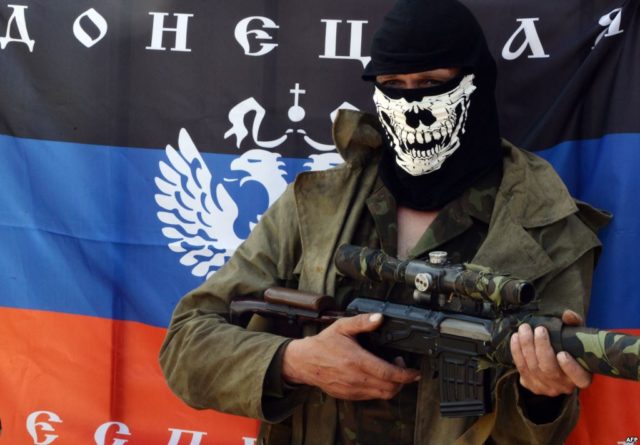
Are the Kremlin’s LPR and DPR About to Unite or Fight Each Other?
Publication: Eurasia Daily Monitor Volume: 13 Issue: 196
By:

The Kremlin has deliberately obscured the so-called Donetsk People’s Republic (DPR) and the Luhansk People’s Republic (LPR), in eastern Ukraine, under a fog of confusion. As such, on a single day last week, a Russian analyst argued that the two self-styled republics are about to unite into one entity (Novorossiya), while at the same time a Ukrainian analyst saw signs that the two Moscow-sponsored statelets are almost at the point of declaring war on each other even though their Russian curators are reportedly purging the most radical Russian nationalists in each.
On one hand, that fog reflects the internal problems of the two self-proclaimed entities—problems that have only been exacerbated by the uncertain future of Donbas. And on the other hand, it reveals the Kremlin’s clear desire to keep as many of its options open as possible. Moscow wants to continue destabilizing Ukraine, even while talking peace; but it also particularly wants to avoid any actions that could lead to a violent reaction against the Kremlin by Russian nationalists in the Russian Federation. The two analysts’ sharply contrasting predictions as to what will happen next in eastern Ukraine, combined with the reports of a Moscow-ordered “cleansing” of the ranks of the Russia-backed militants there, provide a remarkable glimpse into developments on the ground in Donbas as well as offer some ideas about the range of options Moscow may choose from in the near future.
In a commentary on Moscow’s Svobodnaya Pressa portal, Russian analyst Dmitry Rodionov says that rumors are swirling in the DPR and LPR that the two may soon join together to restart Vladimir Putin’s “Novorossiya” project (Svpressa.ru, December 8). Such a union would make the DPR the dominant local player and would likely set the stage for more Russian aggression deeper into Ukraine.
The Moscow commentator suggests that there is more enthusiasm for this idea among DPR leaders than among their counterparts in Luhansk; and he further adds that the former may be prepared to use a show of force to secure such an outcome. That possibility opened the way for Ukrainian analyst Aleksey Konstantinov to draw the conclusion that the two Russian supported statelets may be on the brink of an open military conflict—a reflection of both the weakness and the desire of the DPR to dominate the situation (Apostrophe.ua, December 8).
On the one hand, of course, this may simply be a case of wishful thinking in Kyiv—a sense that the two Russian entities have been weakened by desertions, incessant fighting, shortages, and the Ukrainian special operations. Indeed, far too often Ukrainian outlets have reported developments that, if true, should have proven the death knell of Putin’s broader project in Ukraine. But on the other hand, precisely because Konstantinov’s words echo in part those of Rodionov, they may represent something more: the descent of these two Moscow efforts into a kind of atamanshchina (see below), with which Ukrainians had their fill at the dawn of Soviet times.
The word “atamanshchina” refers to the rule of the atamans, formal or often informal Cossack leaders who ruled by force and violence and served their own interests rather than any broader political or ideological agenda. Some of them fought for a time on the side of the Bolsheviks, and others on the side of the anti-Bolshevik White Russians. But at all times, they fought for themselves and represented a danger to anyone trying to impose state order on them. Indeed, it took the brutality of the Red Army and the Cheka some years to wipe them out across the Soviet Union.
And that makes the third report, about Russian efforts to purge the most committed and radical Russian nationalists from the ranks of leaders in the DPR and LPR especially significant. Leaders of such groups, including Aleksandr Khodakovsky of the so-called Patriotic Forces of Donbas, are complaining loudly about this (Patriot-Donetsk.ru, December 7; Evrazia.org, December 10). When Moscow invaded Ukraine, the Kremlin was only too pleased to have Russian nationalists as volunteers there. But now that the situation has dragged on, the Russian government is less happy about such people, both because they are less subject to discipline and because, on returning to Russia, they are a problem for the authorities—people with military experience and angry about Moscow’s failure to advance further into Ukraine.
Moscow clearly wants to rid itself of these people in order to strengthen its control of the situation, but the Russian authorities do not want them to come back home. Combining the DPR and LPR is one way to do that because it eliminates some of the positions Moscow has to ensure are staffed. But having the two fight it out is even better as there is a good chance that some of these Russian nationalist radicals would be killed—and that others would see the fight as evidence of Moscow’s willingness to renew the battle for Novorossiya. Consequently, these three reports taken together point to a conclusion that must be worrisome to Ukraine and all who care about its future: Moscow is hunkering down in Donbas for the long term and is working to create the kind of disciplined force it would use to expand its aggression into Ukraine.



